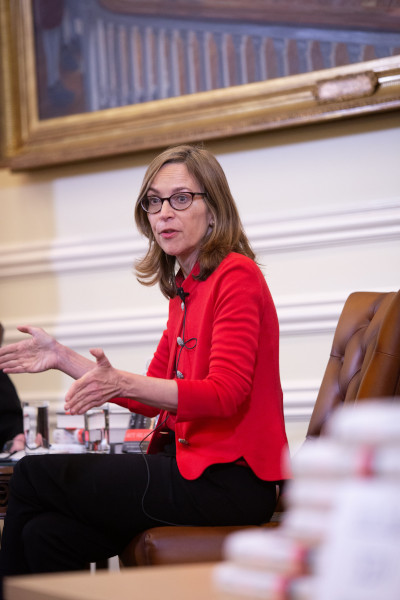A lecture at Hillsdale in D.C. by Amity Shlaes

By Krystina Skurk
Lyndon B. Johnson’s Great Society made one promise - to cure poverty. Why couldn’t this promise be kept? Author Amity Shlaes answers this question and many more in her discussion with Dr. Matthew Spalding on her new book: Great Society: A New History.
Dr. Shlaes chairs the board of the Calvin Coolidge Presidential Foundation, is the winner of the Hayek Prize, serves as a Presidential Scholar at The King’s College, and has also written The Forgotten Man: A New History of the Great Depression, Coolidge - a full-length biography of the thirtieth president, and several other books.
In her new book Shlaes seeks to right the record on the idealized era of the Great Society. Her book explores the truth behind the consequences of both Lyndon B. Johnson’s and Richard Nixon’s expansive government programs. Shlaes explained to the audience that the 1960s are not usually taught or written about chronologically. Instead the era is most often taught thematically. She argued that this makes the era both hard to study and hard to analyze. Her new book seeks to correct this by teaching the era as most history is taught - from beginning to end.
The Great Society programs and mindsets are still with us today, Shlaes explained. For example presidential candidate Michael Bloomberg recently declared that it was time for a “war on poverty,” a phrase from the Great Society, she said. Shlaes shared that today the United States spends more on programs created during the Great Society than on programs from the New Deal era.
The 1950s were going well, Shlaes said, so well that progressives got overly ambitious and started to believe that they could cure poverty. However, “We did not cure poverty, even though Franklin Roosevelt hoped we might and Lyndon Johnson swore we would,” she said.
While most of the work of the progressives was relegated to states, the Great Society sought to nationalize welfare programs. “We never imagined we would be running the social work business from Washington D.C.,” Shlaes said.
The Great Society was influenced both by the progressive movement and the Fabian socialist movement from Great Britain. When the British used the term Great Society they were referring to a network of interconnected towns. “They realized that if a society is going to be great, meaning broad and high, it must have great planners,” Shlaes said.
Dr. Spalding pointed out that the main elements in Johnson’s Great Society were healthcare, education, and the environment. Shlaes agreed, explaining that Johnson spent a lot of time travelling by car and thus prioritized beautifying highways. He was also a former school teacher and believed that education was the answer to poverty.
Why didn’t the Great Society work? Why wasn’t President Johnson, with the full power of the federal government behind him, able to cure poverty? Shlaes points to what famed Austrian economist Frederick Hayek called the “knowledge problem.” Shlaes states that “government is insulated from knowledge by the political process. The government only gets feedback on its policies after elections.” Since the government is often “insulated from reality” it does not figure out that anything is wrong until much damage has already been caused, she said.
On the other hand, the market reacts quickly to problems and can thus solve them in real time. The market is too varied, too large, and too complex for even an entire city full of experts to plan it effectively. There is no person or group of people capable of such a feat.
During the question and answer portion of the evening an audience member asked if the utopianism during the era of the Great Society was left unchallenged because of a lack of belief in civil society. In her response Shlaes said that the Great Society did seek to bulldoze the institutions of civil society. Shlaes followed up with a story about three companies - General Electric, Toyota, and the company that became Intel. These companies did social things. Intel had a factory on a reservation and became the greatest private sector employer of Native Americans. The Private Sector can do more than we think to solve social problems yet we opted for the public sector in the Great Society, she said.
“Why are we doing this again, why didn’t we learn our lesson?” Dr. Spalding asked. Nothing is new, it is just forgotten and people have forgotten just how bad the 1970s were, she responded.
Shlaes said another lesson for today is “to beware of marginal increases.” Hayek believed that centralized economic planning leads to serfdom. We can get on Hayek’s Road to Serfdom even by taking little steps, she said.